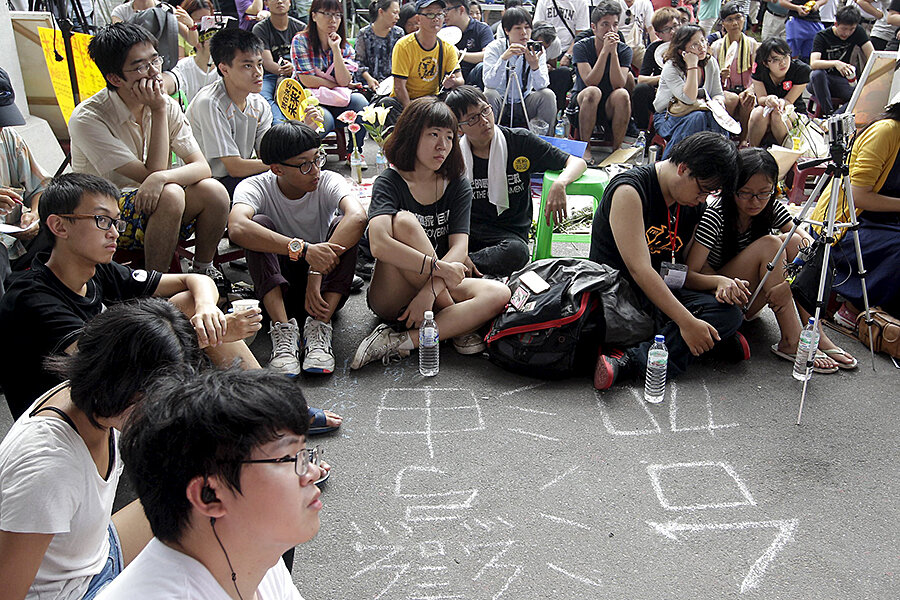In Taiwan, protests over history textbooks are about the future
Loading...
Emotional protests in Taiwan over new history textbooks that students claim will “brainwash” them with “China-centric” views are actually more about the future than the past, analysts say.
For two weeks hundreds of Taiwanese citizens led by high school students have repeatedly taken to the streets and twice tried to storm the ministry of education to oppose a textbook revision they say is an ideological argument for Beijing’s “one-China” policy that seeks reunification.
The protests are the largest in Taiwan in more than a year and reflect a growing shift on the island from cultural identification with China to a more Taiwanese identity. They also reflect a new activism by younger generations first seen in Taiwan's "Sunflower movement" in 2014 and more recently in Hong Kong's "Occupy Central" movement that challenged Beijing's rules on elections.
“We are Taiwan. China is China,” Liu Tzuhao, 18-years old, told Reuters as she stood at a makeshift memorial to a student in Taipei who committed suicide over the controversy.
Protesters object to curriculum changes they say were carried out without consultation and by a committee that did not operate in a transparent manner and whose interpretations of history they say skew towards China’s historic claims on the island.
The changes involve new wordings that to an outsider may seem small but in the intricate and sensitive definitions in East Asia signify large conceptual shifts. One includes Taiwan being “recovered by China” from Japan after World War II instead of being “given to China.”
On Monday negotiations between students and education minister Wu See-hwa broke up as Mr. Wu refused to retract the new books, which go on sale next week. Today the China-friendly ruling- KMT party led by President Ma Ying-jeou said it would not prosecute 32 students who were arrested trying to forcibly enter the education ministry.
Underneath the protest is a furious little struggle over identity between the older KMT, which under President Ma has sought greater convergence with China, and the newer Taiwan-first “green” forces of opposition that are more suspicious of Beijing.
Taiwan’s 2014 student-led “Sunflower movement” appears to have marked a terrific shift in opinion about how to treat with China. Indeed, the textbook revisions started two years ago, a time when Ma’s KMT and Beijing were in increasing accord.
Yet in the spring of 2014 the Sunflower movement was launched when students occupied government buildings for 24 days to protest a series of trade agreements with China engineered and mostly signed off on outside public purview.
The Taiwanese public was shocked and the Sunflower movement then fed a huge political upset last fall when the KMT was kicked out of many city and regional governments.
Radio Free Asia writes this week as background on Taiwan:
Democratic Taiwan has been governed separately from the mainland since the defeated Kuomintang army and government retreated there after being routed by Mao Zedong's communist forces on the mainland, and the government regards itself as the last bastion of the Republic of China created by the 1911 revolution that toppled the Qing Dynasty.
But Beijing still regards the island as a renegade province awaiting reunification, and has said it won't rule out the use of military force should the island ever seek formal independence as Taiwan.
One Sunflower protester, June Lin, speaking by phone from Washington where she now works as an intern at a Taiwan lobby group, says that Sunflower activists aided the high school students in Taipei.
She argues that it is as much the textbook's portrayal of the KMT as China that worries students. "The concerns of the students about the content of the textbook is not just that it repeats one-China ideology, but that it also makes it seem that in 1949, the Kuomintang forces coming to China were the cleanest and best in the world. The revision justifies everything the KMT did and makes them seem blameless.”
The youth protests have a similar flavor to the ones protests that froze nearby Hong Kong last fall, when the “Occupy Central” protest swept downtown streets and challenged Beijing over rulings about how free and fair Hong Kong elections can be.
China itself, under new leader Xi Jinping, is entering a more authoritarian phase with more strictures on civil society and freedom of expression.





